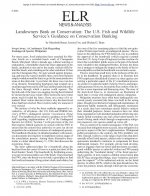Landowners Bank on Conservation: The U.S. Fish and Wildlife Service’s Guidance on Conservation Banking
By Marybeth Bauer, Jessica Fox, Michael Bean View PublicationFor many years, fossil enthusiasts have searched for Miocene fossils on a secluded beach south of Chesapeake Beach, Maryland. About a decade ago, without warning or explanation, a formidable chain link fence appeared on the beach, anchored at one end to the nearly vertical cliffs behind
the beach, and extending at the other end about 30 feet into the Chesapeake Bay. No sign warned against trespassing, and since the water is shallow there, most fossil hunters simply waded around the fence to get to the more productive areas on the other side. A year later, the fence was even less of an obstacle. Enterprising beachgoers had scraped out a small passage between the cliff face and the landward end of the fence through which a person could squeeze. The bayside end of the fence was sagging, having been battered
by storms the previous winter. More storms the next winter pretty much leveled the fence. Soon, not a trace of it remained. Most visitors then never knew why the short-lived fence had been erected. Most visitors today are unaware it ever existed.

